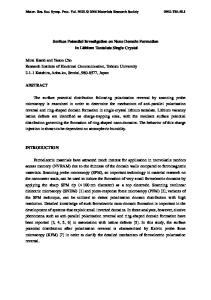Preparation, electrical, thermal and mechanical properties of black lithium tantalate crystal wafers
- PDF / 1,179,515 Bytes
- 6 Pages / 595.276 x 790.866 pts Page_size
- 43 Downloads / 395 Views
Preparation, electrical, thermal and mechanical properties of black lithium tantalate crystal wafers Xuefeng Xiao1,2,3 · Huan Zhang1,2 · Xuefeng Zhang1,3 Received: 25 May 2020 / Accepted: 5 August 2020 © Springer Science+Business Media, LLC, part of Springer Nature 2020
Abstract In this work, the effect of surface reduction treatment on the electrical, thermal and mechanical properties of Lithium tantalate (LiTaO3, LT) crystal wafers was investigated by comparing congruent Lithium tantalate (CLT) crystal wafers with deep-reduction black Lithium tantalate (BLT) crystal wafers using a mixture of high-purity aluminium powder and silicon powder as reducing agents. The structural changes of reduced wafers are discussed by XRD. The electrical conductivity of BLT wafers is 6.27 × 10–12 (Ω cm)−1, which is four orders of magnitude higher than the CLT crystal wafers. The Curie temperature and the thermal stability are basically the same with CLT crystal wafers, and the specific heat and hardness are reduced. The data show that high temperature annealing before reduction is conducive to the stress release of CLT crystal wafers, the blackening effect is more easily achieved, and the treated BLT wafer is more anti-static. The results show that the reduction treatment can obviously improve the conductivity of the wafer, so it is easier to improve and eliminate the discharge phenomenon caused by pyroelectric effects in the process of device preparation.
1 Introduction Lithium tantalate ( LiTaO3, LT) crystal has excellent piezoelectric, thermoelectric, photoelectric and other properties. It is a very important multifunctional crystal material, especially as a piezoelectric wafer material and it is mainly used as a signal filter material in mobile phones [1–10]. The application of lithium tantalate (LT) crystal is commonly congruent lithium tantalate (CLT) crystal. This crystal is usually prepared by the Czochralski method in air, or grown in anoxic conditions. The crystals are usually colourless or pale yellow and their resistivity is usually in the range of 1014–1015Ω cm. In the process of making a filter, due to the need for heating, there is an accumulation of charge on the surface of the substrate which generates sparks causing a change of the surface pattern and which further causes * Xuefeng Xiao [email protected] 1
Key Laboratory of Physics and Photoelectric Information Functional Materials Sciences and Technology, North Minzu University, Yinchuan 750021, China
2
College of Electric and Information Engineering, North Minzu University, Yinchuan 750021, China
3
Ningxia Ju Jing Yuan Crystal Technology Company Limited, Shizuishan 753000, China
surface microcracks, resulting in a reduction of the yield. This is due to the relatively strong pyroelectric property of CLT crystals. In addition, the image resolution is reduced because of the high light transmittance of the CLT crystal and the reflection of light on the back of the substrate during photolithography [5, 6]. However, the thermal and mechanical prop
Data Loading...









